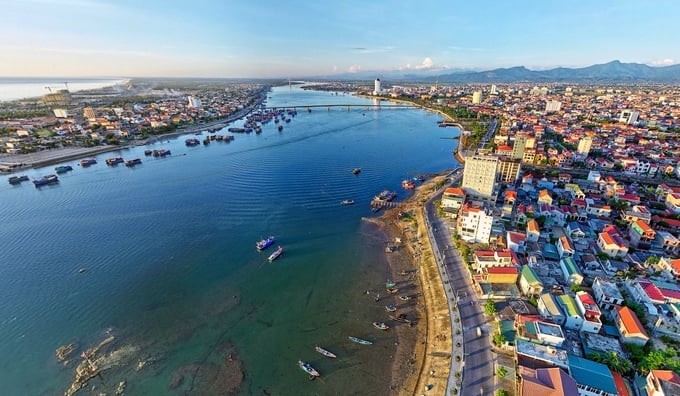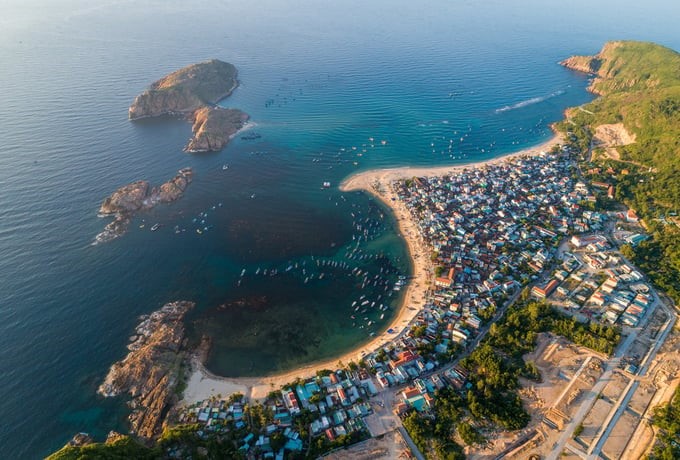November 26, 2025 | 20:46 GMT +7
November 26, 2025 | 20:46 GMT +7
Hotline: 0913.378.918
November 26, 2025 | 20:46 GMT +7
Hotline: 0913.378.918

Dong Hoi city, Quang Binh province, is on the banks of the Nhat Le River.
Among Vietnam's 28 coastal provinces and cities, 15 localities have coastlines of 100km or more, and 11 provinces are located in the North Central and Central Coast regions. Of these, the five provinces with the longest coastlines in the region are Khanh Hoa (370km), Binh Thuan (192km), Phu Yen (182km), Ha Tinh (137 km), and Binh Dinh (134km).
Therefore, in addition to rapid, sustainable development and leading the country in the ocean economy, the North Central and Central Coast regions also focus on building synchronous, modern, green, and smart infrastructure. The urban system is linked into a synchronous network with typical, rich-identity, green, civilized architecture and the ability to withstand and adapt to climate change.
By 2050, the North Central and Central Coast will develop at least 2 urban areas and a number of large industrial, service, and international cooperation centers, on par with the Asian region, in modern coastal economic zones; develop civilized, modern, green rural areas rich in national cultural identity.
At the same time, develop a good-quality environment and harmonious society where cultural and historical values and marine, island, and forest ecosystems are preserved and promoted. People's material and spiritual lives will reach a high level; national defense, security, and sovereignty over seas and islands will be firmly guaranteed.
To achieve the above goals, the planning focuses on developing ocean economic sectors; improving productivity and quality based on the application of science and technology, innovation, and digital transformation. Strongly developing a number of industries, such as the semiconductor and chip manufacturing industry; financial, commercial, and logistics services. Developing science and technology; innovation; and forming research, training, and transfer centers for new technologies such as semiconductor chips, artificial intelligence, and clean energy.
Along with that, improve the business investment environment and build specific mechanisms and policies for regional development. Complete infrastructure projects and introduce policies to encourage people to stick to the sea. Build effective renewable energy and clean energy projects in coastal areas with favorable conditions and high potential, associated with promoting tourism development and maximizing the region's advantages.
With much potential, the North Central and Central Coast regions have many factors to become key tourist areas of the country. According to the plannìng, many provinces belong to the driving area for national tourism development, including: (1) Ninh Binh - Thanh Hoa - Nghe An; (2) Quang Binh - Quang Tri - Thua Thien Hue - Da Nang - Quang Nam; and (3) Khanh Hoa - Lam Dong - Ninh Thuan - Binh Thuan.

The planning for the North Central and Central Coast regions focuses on developing ocean economic sectors and improving productivity and quality based on the application of science and technology, innovation, and digital transformation. Photo: VGP.
The North Central and Central Coast's orientation is to develop economic corridors along the North-South axis and East-West economic corridors to effectively connect seaports, economic zones, airports, international border gates, major trade hubs, coastal cities, economic centers, and growth poles.
At the same time, synchronously develop the seaport system in the provinces in the region; upgrade, renovate, and improve the operational efficiency of nine existing airports in the region.
On that basis, the region determines to participate deeply in the global value chain and build a number of large-scale industrial clusters with high international competitiveness. Increase the contribution rate of the industrial sector to the region's GRDP to about 25–35%.
Focus on industrial development along the North-South economic corridors and East-West economic corridors associated with seaports and national highways connecting to the Central Highlands. Expand the industrial distribution space to the West of the North-South Expressway East.
Develop the petrochemical refining industry and production of refined petroleum products concentrated in Thanh Hoa, Quang Ngai, Khanh Hoa, and Phu Yen; prioritize renewable energy production in Quang Binh, Quang Tri, Quang Nam, Quang Ngai, Binh Dinh, Ninh Thuan, and Binh Thuan; and build inter-regional renewable energy industrial and service centers in Ninh Thuan and Binh Thuan.
Form modern, professional logistics zones, applying advanced technology and meeting international integration requirements; form logistics centers associated with seaports, airports, and border gates. Develop regional and national logistics centers based on the regional seaport system and main international transport corridors, striving to contribute over 6% of the country's total logistics revenue.
Coastal cities are planned to be harmoniously linked with the exploitation of oil and other marine mineral resources; develop the aquaculture, seafood exploitation, and processing industries in parallel with protecting the marine environment; and develop coastal and offshore industries.
Before announcing the planning for the North Central and Central Coast regions, many provinces in the area were also determined to invest heavily in the ocean economy. For example, Binh Dinh strives to become an ocean economic center with an average GRDP growth rate of 8.5% or more in the 2021–2030 period.
The whole country currently maintains six socio-economic regions, including the Northern Midlands and Mountainous region (14 provinces), the Red River Delta (11 provinces and cities), the North Central and Central Coast (14 provinces), the Central Highlands (5 provinces), the Southeast (6 provinces and cities), and the Mekong Delta (13 provinces and cities).
Translated by Thu Huyen

(VAN) After the institutional merger, Da Nang possesses significant forest-carbon reserves and is proactively engaging in the carbon market, creating a new revenue stream.

(VAN) An Giang strengthens communication against IUU fishing, increases inspections and sanctions, and is determined to remove the EC’s “yellow card” while developing a sustainable fisheries sector.

(VAN) As green transition becomes a global trajectory, Viet Nam’s biggest challenge is not only technology and models, but how to ensure that capital flows reach the right beneficiaries.

(VAN) The Ministry of Agriculture and Environment must spearhead the construction of green governance, spanning decision-making processes and investment standards to policy evaluation mechanisms.

(VAN) The Agriculture and Environment sector of Khanh Hoa has achieved numerous milestones over the past 80 years, contributing significantly to the goal of establishing the province as a centrally governed city by 2030.

(VAN) Viet Nam is entering the pivotal period of 2025-2030, moving toward the formulation of the Remote Sensing Law, which will establish a legal foundation for the development of national digital data.

(VAN) The agricultural sector is finalizing the strategic framework for emission reduction, setting the goal of sharply cutting methane and 403.7 million tons of CO2 equivalent and moving toward Net Zero by 2050.